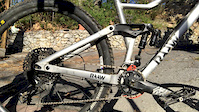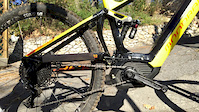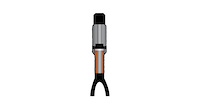Video player is disabled while the embed window is open.
Copy and paste the HTML code below:
Color:
Size: X
|
| |
Nicolai derailleur vs Pinion drop test
Nicolai derailleur vs Pinion drop test
10 Comments
- + 3
Is a this a good test? Is it perceived as good damping or good linkage kinematics if the back wheel has minimal bounce? If you can offer some insight that would be great!
- + 5
Compare the amount of bounce in the back wheel between the derailleur bike and the gearbox bike; you'll see that the gearbox bike bounces much less. If you look closely, you can also see that the gearbox bike's rear suspension is compressing more - this is the real point. This is because the gearbox bike's frame weighs more than the derailleur bike's frame, thanks to the extra weight of the gearbox. The extra weight is activating the suspension, meaning that the energy of the drop is being absorbed by the shock's damping circuit, rather than being stored in the tire and then returned as bounce. Basically, the idea is that the extra weight keeps the wheel stuck to the ground by requiring the rear suspension to be more active. This is the idea of sprung versus unsprung mass: for a given total system weight (i.e., bike plus rider) the more weight is "above" the suspension, the better the suspension will work. In practical terms, this means getting weight off the wheels and onto the frame or rider, since the wheels are "below" the suspension. So getting weight off the rear wheel and onto the frame (by losing the cassette and adding the gearbox) improves the ratio of sprung mass to unsprung mass, and makes the suspension work better. This is what you see in the video.
Incidentally, this is the same reason the article mentions the difficulty of keeping up with heavy riders over rough ground: a heavier rider also results in a better sprung mass ratio. This is also the reason why the gearbox makes much less of a difference in real life than it does in the video. In real life, you have to include the weight of the rider, as well as the bike. Without the rider, losing the cassette and adding the gearbox probably changes the the sprung:unsprung mass ratio from about two kilos for the rear wheel and one kilo for the frame, to about one kilo for the rear wheel and about three kilos for the frame. Going from 2:1 kg to 1:3 kg is a 600% percent difference - which is why you can actually see the difference in the video. But if you add the weight of the rider (~90kg), that becomes a change from 2:91 to 1:93, which is only a 1.1% difference. A 1.1% improvement is certainly enough for a good rider to feel, and almost exactly matches the 1.6% average time improvement that Paul reported in the article.
Of course, if you wanted the same benefits, you could just bolt some lead weights to your bottom bracket. But heavy bikes are bad, right?
Incidentally, this is the same reason the article mentions the difficulty of keeping up with heavy riders over rough ground: a heavier rider also results in a better sprung mass ratio. This is also the reason why the gearbox makes much less of a difference in real life than it does in the video. In real life, you have to include the weight of the rider, as well as the bike. Without the rider, losing the cassette and adding the gearbox probably changes the the sprung:unsprung mass ratio from about two kilos for the rear wheel and one kilo for the frame, to about one kilo for the rear wheel and about three kilos for the frame. Going from 2:1 kg to 1:3 kg is a 600% percent difference - which is why you can actually see the difference in the video. But if you add the weight of the rider (~90kg), that becomes a change from 2:91 to 1:93, which is only a 1.1% difference. A 1.1% improvement is certainly enough for a good rider to feel, and almost exactly matches the 1.6% average time improvement that Paul reported in the article.
Of course, if you wanted the same benefits, you could just bolt some lead weights to your bottom bracket. But heavy bikes are bad, right?
- + 1
@theminsta: in the article, it talks about both impact absorption and noise levels. Still, this is super impressive for an air shock equipped bike at effective top-out.
- + 1
@Jubbylinseed: Have you ever wondered why MTBs ride horrible compared to motorcycles? The simple reason is that the ratio of the sprung mass/unsprung mass is much higher for a motorcycle. This makes the suspension more effective. It is one of the reasons why a Cadillac rides like a Cadillac.
Well, I found a way to add Inertia instead of Mass. I can influence the unsprung/sprung mass ratio using a simple mechanical device.This makes your damper work better and more effectively and reduces the forces transmitted to the body (sprung mass). It effectively eliminates 'valve lag' which, if you're an avid MTB, is pretty much the reason suspension never feels as effective as it should, it simply isn't moving because you are! This is my 'gofundme' page for the project, if you want some basic info. on the design.
www.gofundme.com/t7m683u4
Thanks, Simon.
Well, I found a way to add Inertia instead of Mass. I can influence the unsprung/sprung mass ratio using a simple mechanical device.This makes your damper work better and more effectively and reduces the forces transmitted to the body (sprung mass). It effectively eliminates 'valve lag' which, if you're an avid MTB, is pretty much the reason suspension never feels as effective as it should, it simply isn't moving because you are! This is my 'gofundme' page for the project, if you want some basic info. on the design.
www.gofundme.com/t7m683u4
Thanks, Simon.
- + 1
Have you ever wondered why MTBs ride horrible compared to motorcycles? The simple reason is that the ratio of the sprung mass/unsprung mass is much higher for a motorcycle. This makes the suspension more effective. It is one of the reasons why a Cadillac rides like a Cadillac.
Well, I found a way to add Inertia instead of Mass. I can influence the unsprung/sprung mass ratio using a simple mechanical device.This makes your damper work better and more effectively and reduces the forces transmitted to the body (sprung mass). It effectively eliminates 'valve lag' which, if you're an avid MTB, is pretty much the reason suspension never feels as effective as it should, it simply isn't moving because you are!
Well, I found a way to add Inertia instead of Mass. I can influence the unsprung/sprung mass ratio using a simple mechanical device.This makes your damper work better and more effectively and reduces the forces transmitted to the body (sprung mass). It effectively eliminates 'valve lag' which, if you're an avid MTB, is pretty much the reason suspension never feels as effective as it should, it simply isn't moving because you are!
- + 1
This is my 'gofundme' page for the project, if you want some basic info. on the design.
www.gofundme.com/t7m683u4
Thanks, Simon.
www.gofundme.com/t7m683u4
Thanks, Simon.











